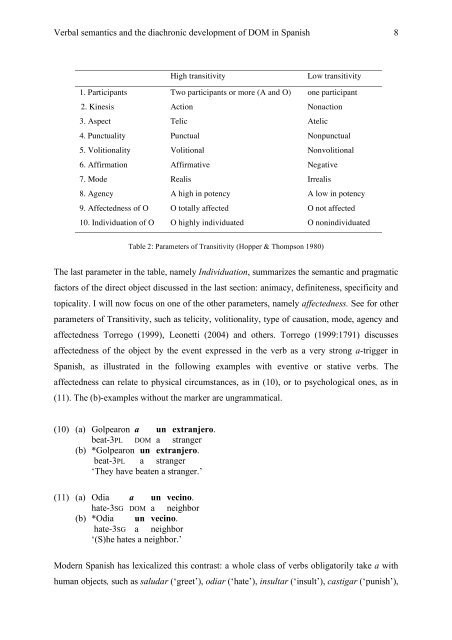Verbal Semantics and the Diachronic Development of Differential ...
Verbal Semantics and the Diachronic Development of Differential ...
Verbal Semantics and the Diachronic Development of Differential ...
Create successful ePaper yourself
Turn your PDF publications into a flip-book with our unique Google optimized e-Paper software.
<strong>Verbal</strong> semantics <strong>and</strong> <strong>the</strong> diachronic development <strong>of</strong> DOM in Spanish 8<br />
High transitivity<br />
Low transitivity<br />
1. Participants Two participants or more (A <strong>and</strong> O) one participant<br />
2. Kinesis Action Nonaction<br />
3. Aspect Telic Atelic<br />
4. Punctuality Punctual Nonpunctual<br />
5. Volitionality Volitional Nonvolitional<br />
6. Affirmation Affirmative Negative<br />
7. Mode Realis Irrealis<br />
8. Agency A high in potency A low in potency<br />
9. Affectedness <strong>of</strong> O O totally affected O not affected<br />
10. Individuation <strong>of</strong> O O highly individuated O nonindividuated<br />
Table 2: Parameters <strong>of</strong> Transitivity (Hopper & Thompson 1980)<br />
The last parameter in <strong>the</strong> table, namely Individuation, summarizes <strong>the</strong> semantic <strong>and</strong> pragmatic<br />
factors <strong>of</strong> <strong>the</strong> direct object discussed in <strong>the</strong> last section: animacy, definiteness, specificity <strong>and</strong><br />
topicality. I will now focus on one <strong>of</strong> <strong>the</strong> o<strong>the</strong>r parameters, namely affectedness. See for o<strong>the</strong>r<br />
parameters <strong>of</strong> Transitivity, such as telicity, volitionality, type <strong>of</strong> causation, mode, agency <strong>and</strong><br />
affectedness Torrego (1999), Leonetti (2004) <strong>and</strong> o<strong>the</strong>rs. Torrego (1999:1791) discusses<br />
affectedness <strong>of</strong> <strong>the</strong> object by <strong>the</strong> event expressed in <strong>the</strong> verb as a very strong a-trigger in<br />
Spanish, as illustrated in <strong>the</strong> following examples with eventive or stative verbs. The<br />
affectedness can relate to physical circumstances, as in (10), or to psychological ones, as in<br />
(11). The (b)-examples without <strong>the</strong> marker are ungrammatical.<br />
(10) (a) Golpearon a un extranjero.<br />
beat-3PL DOM a stranger<br />
(b) *Golpearon un extranjero.<br />
beat-3PL a stranger<br />
‘They have beaten a stranger.’<br />
(11) (a) Odia a un vecino.<br />
hate-3SG DOM a neighbor<br />
(b) *Odia un vecino.<br />
hate-3SG a neighbor<br />
‘(S)he hates a neighbor.’<br />
Modern Spanish has lexicalized this contrast: a whole class <strong>of</strong> verbs obligatorily take a with<br />
human objects, such as saludar (‘greet’), odiar (‘hate’), insultar (‘insult’), castigar (‘punish’),

















